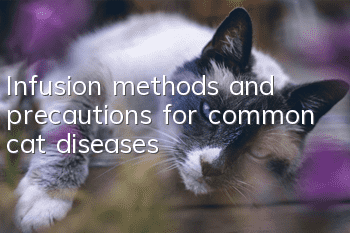Infusion methods and precautions for common cat diseases

Infusion therapy is very common. Oral medicine may be convenient, but the effect may not be that fast. The effect of infusion is often immediate. The most common one is the lack of body fluids after heat stroke in cats, which requires the replenishment of normal saline. However, some serious cases Diseases and inflammations must be treated with infusions and oral medications.
Infusion is of great significance in correcting electrolyte imbalance, acid-base balance, and body fluid balance. Infusion itself can delay the disease, prolonging life is of great significance to gain treatment time. The indications for infusion are very wide and include the following aspects: ① Correct body fluid balance; ② Correct electrolyte balance; ③ Correct acid-base balance; ④ Maintain normal osmotic pressure; ⑤ Adjust blood volume for bleeding; ⑥ Diarrhea; ⑦ Vomiting; ⑧ Polyuria; ⑨ Shock; ⑩ Provide energy and medicine. However, the test must be conducted before infusion to avoid affecting the test results.
Intravenous drip is the most commonly used and most effective method of rehydration. The main site is the veins of the limbs, and the best is the small saphenous vein of the hind limbs, which is located on the inside of the calf. The tail vein can also be used, but is more difficult. The drugs used for intravenous rehydration are mostly sugar saline, normal saline or compound normal saline. Other drugs can be added according to the situation. Generally, the dosage should be controlled at 25 to 50 ml per kilogram of body weight, and the speed should not exceed 20 to 25 drops per minute. Usually once a day, if the condition is serious, it can also be done 2 to 3 times a day. Secondly, there are different methods for different symptoms.
1. Infusion for diabetic ketoacidosis
1. The first choice is to infuse 0.9% normal saline or Ringer's solution
2. When animals have polyuria, add 10% KCL solution, because potassium ions are consumed in large quantities and insulin will reduce serum potassium ion concentration.
3. Infuse appropriate amount of 5% sodium bicarbonate at the same time.
2. Infusion of animals with liver disease
1. Dilute Ringer's solution and 5% glucose solution one to one, and combine them with potassium ions for supplementation.
2. Do not use stored blood or plasma because they can cause hepatic encephalopathy.
3. Avoid using lactated Ringer's solution as much as possible, because lactic acid needs to be converted into bicarbonate by the action of lactate dehydrogenase in the liver, and this process is blocked in severe liver disease.
3. Infusion of animals with heart disease
1. 5% glucose solution infusion is preferred to avoid excessive sodium ions from aggravating the burden on the heart.
4. Infusion of animals with pancreatitis and peritonitis
1. Infuse balanced electrolyte solution (0.9% normal saline, 5% sugar saline, compound saline, etc.), and potassium ions need to be supplemented.
2. If the total protein drops below 40 g/L, transfuse plasma, albumin or dextran.
5. Infusion of animals with severe diarrhea
1. Choose lactated Ringer’s solution or Ringer’s solution + 5% NaHCO3 solution (correct acidosis)
2. When the animal produces urine, inject 10% potassium chloride.
3. If hypoalbuminemia occurs, transfuse plasma, albumin, globulin or dextran.
6. Infusion of animals with acute and chronic renal failure
1. Do not infuse solutions containing potassium ions initially to avoid the formation of iatrogenic hyperkalemia.
2. Animals suffering from chronic renal failure are usually accompanied by hypokalemia, so Ringer’s solution + 10% KCl solution is the first choice for infusion.
7. Infusion of animals with hypovolemia and hemorrhagic shock
1. Choose isotonic electrolyte solution (0.9% normal saline, Ringer's solution) or hypertonic liquid (5% sugar saline).
2. If HCT drops to less than 20%, transfuse whole blood or accumulated cells.
3. If TP drops to 40 g/L, transfuse plasma, albumin or dextran.
4. When azotemia occurs, especially when oliguria occurs or the serum potassium ion concentration cannot be measured, a solution without potassium ions should be administered.
8. Infusion of animals with severe vomiting
1. 0.9% normal saline or Ringer's solution is preferred, and 5% sugar saline can also be given.
2. Starting from the initial polyuria, add 10% KCl solution.
9. Infusion of heat stroke animals
1. Heat stroke is a typical form of hypertonic dehydration (plasma hypertonicity and high sodium, water loss is greater than sodium loss, and water is lost through breathing).
2. Infusion should be mainly water replenishment, supplemented by sodium replenishment. Choose 5% glucose solution or 5% glucose solution and 0.9% normal saline for infusion in a ratio of 1:1.
10. Infusion of animals with pleural and abdominal effusion
1. Drainage of inflammatory exudate in the thoracoabdominal cavity, large and repeated drainage of chest and ascites and other medical treatments.
2. Isotonic solution (0.9% normal saline, Ringer's solution) is preferred because it is isotonic dehydration.
Note:
The speed of infusion should not be too fast, and the amount of infusion should not be too large. The cat’s heartbeat and breathing should be closely monitored, and the cat’s clinical manifestations should be paid attention to at all times. When infusing a weak cat, the infused liquid should be warmed in a water bath. It can be heated to the cat's body temperature before infusion.. And keep the surrounding environment quiet and warm to avoid adverse stimulation to the cat. When a cat experiences vomiting or other symptoms of discomfort, the infusion speed should be reduced, the infusion should be stopped if necessary, and corresponding treatment measures should be taken.
- What causes vomiting in cats? How to prevent and treat vomiting in cats?
- How to train a British shorthair cat? It’s actually very simple!
- Why is the cat screaming?
- Are there any long-haired Siamese cats?
- Reasons why cats squat
- Things to note when buying a cat litter box
- What happens if a cat eats too much grass?
- How to tell if a cat has fleas
- After a cat is "spoiled", it will have these major characteristics. How many of these characteristics does your cat have?
- My son and I’s journey of raising cats



